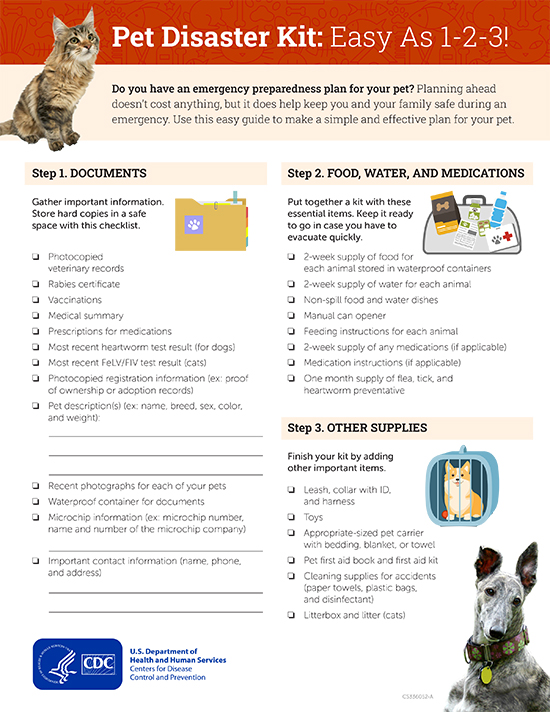Pet Emergency Preparedness: Tips for Evacuation Plans
Introduction
When disaster strikes, it is crucial to have a well-thought-out evacuation plan in place for your entire family, including your beloved pets. Whether it’s a natural disaster like a hurricane, flood, or wildfire, or a man-made emergency such as a chemical spill or terrorist attack, being prepared can make all the difference in ensuring the safety and well-being of your furry friends. In this blog post, we will discuss some essential tips for pet emergency preparedness and creating effective evacuation plans.
1. Create a Pet Emergency Kit
When preparing for an evacuation, it’s crucial to have a pet emergency kit ready. This kit should include:
- Food and water for at least three days
- Medications and medical records
- Leashes, collars, and harnesses
- Comfort items like blankets and toys
- Recent photos of your pets
2. Keep Identification Tags Updated

Ensure your pets have identification tags with up-to-date contact information. In case you get separated during an evacuation, this will increase the chances of being reunited with your furry friends.
3. Microchip Your Pets
Microchipping your pets is another essential step in pet emergency preparedness. If your pets lose their collars or tags, a microchip can help identify them and facilitate their safe return.
4. Research Pet-Friendly Evacuation Shelters
Not all evacuation shelters accept pets, so it’s crucial to research and identify pet-friendly shelters in your area. Keep a list of these shelters handy, along with their contact information.
5. Plan for Temporary Accommodations
If you need to evacuate, it’s important to have a plan for temporary accommodations. Reach out to friends, family, or pet-friendly hotels in advance to ensure you have a safe place to stay with your pets.
6. Practice Evacuation Drills
Regularly practice evacuation drills with your pets to familiarize them with the process. This will help reduce stress and anxiety during an actual emergency situation.
7. Pack Essential Documents
Make copies of important documents such as vaccination records, licenses, and ownership papers. Keep these copies in a waterproof bag or folder as part of your pet emergency kit.
8. Prepare a First Aid Kit
Include basic first aid supplies in your pet emergency kit, such as bandages, antiseptic solution, and any necessary medications.
Summary
Having a solid evacuation plan that includes your pets is vital to their safety during emergencies. Here are some key points to consider:
- Identify pet-friendly shelters or accommodations in advance.
- Prepare an emergency kit for your pets with essential supplies.
- Ensure your pets are properly identified with tags or microchips.
- Keep important documents and medical records handy.
- Practice evacuation drills with your pets to reduce stress.
By following these tips and being proactive read more in your pet emergency preparedness efforts, you can minimize the risks and ensure the well-being of your furry companions during times of crisis.
- Q: What should I include in my pet emergency evacuation kit?
- A: Your pet emergency evacuation kit should include essential items such as food, water, medications, a leash, a collar with identification tags, a carrier or crate, blankets, and any necessary documents or medical records.
- Q: How can I ensure my pet’s safety during an evacuation?
- A: To ensure your pet’s safety during an evacuation, make sure they are wearing identification tags with updated contact information. Keep them on a leash or in a carrier at all times, and have a plan in place for where you will take them in case of an emergency.
- Q: What should I do if I am unable to bring my pet with me during an evacuation?
- A: If you are unable to bring your pet with you during an evacuation, try to find a trusted friend, family member, or pet boarding facility who can care for them temporarily. Make sure to provide them with all necessary supplies and information about your pet’s needs.
- Q: How can I prepare my pet for a potential emergency situation?
- A: To prepare your pet for a potential emergency situation, make sure they are comfortable being in a carrier or crate. Practice evacuating with them and familiarize them with the sound of alarms or sirens. Keep their vaccinations up to date and have a current photo of them for identification purposes.
- Q: What should I do if my pet gets injured during an emergency?
- A: If your pet gets injured during an emergency, it is important to remain calm. Assess their condition and provide basic first aid if necessary. Contact a veterinarian as soon as possible for further guidance and assistance.

